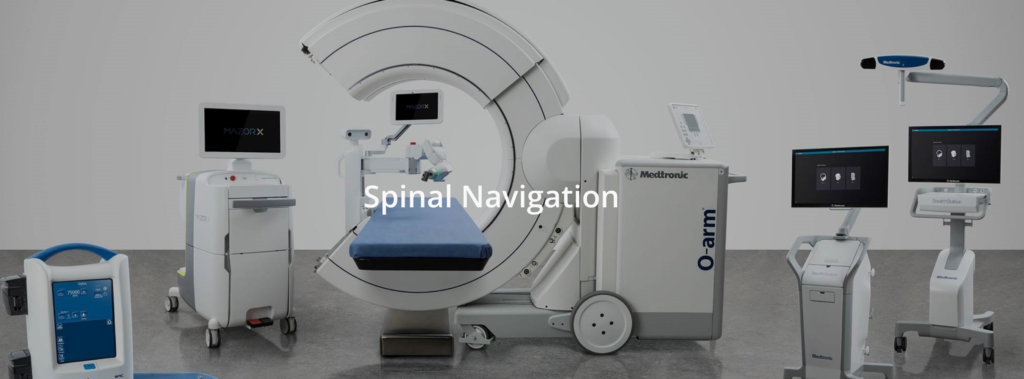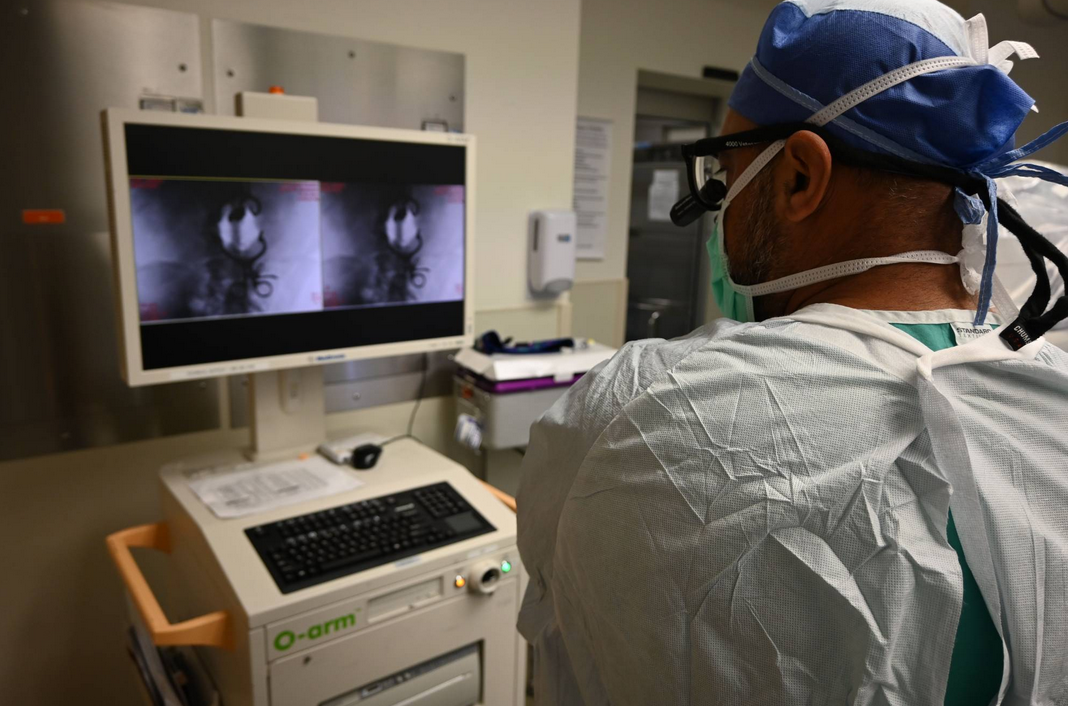In recent years, advancements in medical technology have revolutionized the way spine surgeries are performed. One of the most significant breakthroughs in this field is spinal navigation, a technology that enhances the precision and safety of spine surgery. For patients experiencing chronic back or neck pain due to conditions like herniated discs, spinal stenosis, or scoliosis, spinal navigation can lead to more accurate and successful outcomes. We leverage spinal navigation technology to deliver state-of-the-art care for our patients.

What is Spinal Navigation?
Spinal navigation is a computer-assisted technology that provides real-time, three-dimensional (3D) imaging of a patient’s spine during surgery. It allows surgeons to navigate the intricate anatomy of the spine with greater accuracy and precision, minimizing the risks associated with traditional surgical techniques.
This system functions similarly to a GPS (Global Positioning System), guiding surgeons through the spinal anatomy by providing detailed images and exact coordinates. Using sophisticated imaging software, spinal navigation helps surgeons plan the surgery, visualize the spine during the procedure, and guide instruments to the precise location, reducing the chances of error.
The Importance of Precision in Spine Surgery
The spine is one of the most complex and delicate parts of the human body. It consists of small vertebrae, discs, nerves, and blood vessels that need to be handled with extreme care during surgery. Even a slight miscalculation during a traditional spinal surgery can lead to nerve damage, complications, or suboptimal outcomes. This is where spinal navigation steps in.
Spinal navigation offers the ability to operate with millimeter-level accuracy, reducing the likelihood of complications and enhancing patient outcomes. The technology assists in:
- Pinpointing problem areas such as herniated discs or spinal deformities.
- Guiding surgical instruments in real time to the affected area, ensuring they are positioned correctly.
- Reducing the need for large incisions, which lowers the risk of infection and decreases recovery time.
How Does Spinal Navigation Work?
The spinal navigation process begins with preoperative imaging, usually in the form of a CT scan or MRI. This data is then uploaded to the spinal navigation system, which creates a 3D map of the patient’s spine. During the surgery, the surgeon uses this map in combination with real-time imaging from intraoperative tools like X-rays or fluoroscopy.
The system’s tracking instruments are attached to the patient’s body, and specialized cameras capture and relay the movements of the surgical instruments to the computer. The surgeon can then see the instruments’ exact position relative to the spinal anatomy on a monitor. This real-time feedback allows the surgeon to make precise adjustments and ensures that the surgery is performed with optimal accuracy.
Benefits of Spinal Navigation
- Enhanced Surgical Precision
Spinal navigation significantly improves a surgeon’s ability to see and navigate the surgical area, ensuring that all surgical actions are precise. This level of accuracy is critical in procedures like spinal fusion, where screws and other hardware must be placed in very specific locations. - Minimally Invasive Procedures
Spinal navigation enables surgeons to perform more minimally invasive procedures, meaning smaller incisions, less tissue disruption, and shorter recovery times for patients. Minimally invasive surgeries typically result in less post-operative pain, a reduced risk of infection, and faster healing. - Reduced Risk of Complications
With the enhanced visualization provided by spinal navigation, surgeons can avoid critical structures like nerves and blood vessels. This minimizes the risk of nerve damage and other complications, which are more common with traditional surgical approaches. - Improved Outcomes for Complex Conditions
For patients with complex spinal conditions like scoliosis, spinal deformities, or multiple levels of degenerative disc disease, spinal navigation allows surgeons to address these issues with greater confidence and accuracy. By ensuring that corrective actions are taken precisely, spinal navigation helps improve overall surgical outcomes. - Real-Time Feedback
During surgery, the surgeon can immediately see the results of each step in the procedure. This real-time feedback is invaluable in ensuring that the surgery progresses smoothly and that any potential issues are addressed before they become complications. - Decreased Radiation Exposure
Traditional spine surgeries often rely on X-rays to guide the surgeon. With spinal navigation, less reliance on X-rays means reduced radiation exposure for both the patient and the surgical team. The advanced imaging technology within the navigation system provides better visualization without the need for constant X-ray checks.
Types of Surgeries That Benefit from Spinal Navigation
Spinal navigation is useful in a variety of spinal procedures, including:
- Spinal Fusion: Spinal navigation assists in the precise placement of screws and hardware during fusion surgeries, improving the stability and long-term success of the procedure.
- Scoliosis Correction: In surgeries to correct spinal curvature, the accuracy provided by spinal navigation ensures that corrective hardware is placed in the optimal position.
- Disc Replacement: Spinal navigation aids in the removal of damaged discs and the placement of artificial discs, ensuring the best possible alignment.
- Minimally Invasive Decompression: For patients with spinal stenosis, spinal navigation helps guide surgical tools to remove bone or tissue pressing on nerves while preserving healthy tissue.
The Future of Spine Surgery
Spinal navigation is a critical tool in the evolution of spine surgery, enabling surgeons to perform more complex and delicate procedures with higher precision than ever before. As technology continues to advance, we can expect even greater enhancements in spinal surgery techniques, further improving patient outcomes and reducing recovery times.
We prioritize using the latest advancements in spinal care to ensure that our patients receive the best treatment possible. If you are suffering from chronic back or neck pain and are considering spine surgery, contact us today to learn more about how spinal navigation can enhance your surgical experience and outcome.
Conclusion
Spinal navigation has transformed the landscape of spine surgery, offering enhanced accuracy, reduced risks, and improved recovery for patients. Whether you’re facing a complex spinal condition or a minimally invasive procedure, this technology ensures that you receive the most advanced care available.


